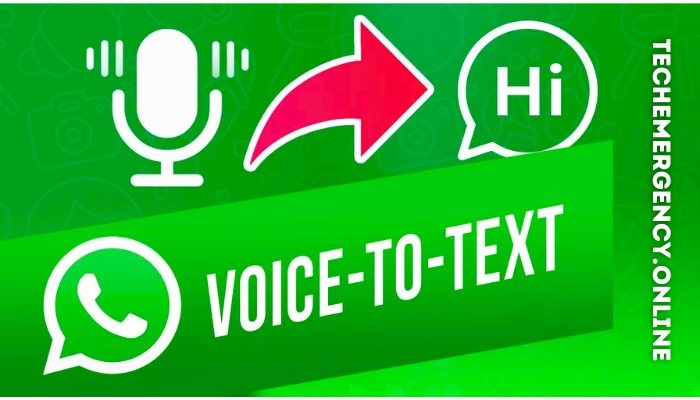Introduction
In the speedy advanced world, comfort is best. WhatsApp Voice to Text Technology Throughout the long haul, WhatsApp has cemented its place as a go-to correspondence stage, interacting billions of clients generally. With each update, it has reliably presented highlights that reclassify the informing experience. The most recent huge advantage? Voice-to-text technology. This inventive component is changing the manner in which clients impart, offering a consistent mix of speed, exactness, and comfort. WhatsApp Revolutionizes Messaging with Voice to Text Technology
What is Voice-to-Text Technology?
Voice-to- text message technology changes over expressed words into composed message utilizing progressed calculations and AI models. This capacity, presently coordinated into WhatsApp, permits clients to decipher voice messages into message, overcoming any issues among voice and customary message based correspondence. WhatsApp Revolutionizes Messaging with Voice to Text Technology
How WhatsApp Voice-to-Text Feature Works
1. Speech Recognition Algorithms
WhatsApp utilizes progressed discourse acknowledgment calculations to interpret expressed words into text precisely. These calculations can recognize various accents, discourse examples, and, surprisingly, minor foundation commotion.
2. AI-Powered Language Models
The element use man-made intelligence to improve record precision, perceiving setting and subtleties in discourse to create more significant text yields.
3. Multi-Language Support
WhatsApp’s voice-to-text technology upholds various dialects, mirroring its worldwide client base and guaranteeing openness across various locales.
4. User-Friendly Interface
The component is planned in light of straightforwardness. Clients essentially tap a record button, and the application shows the text rendition of the voice message continuously or not long after handling.
Key Benefits of WhatsApp’s Voice-to-Text Technology
1. Time Efficiency
For clients in a rush, perusing a record is frequently faster than standing by listening to a whole voice message.
2. Increased Privacy
Voice messages aren’t generally ideal out in the open or calm conditions. Records permit clients to carefully get to message content.
3. Enhanced Accessibility
This element engages clients with hearing troubles to take part in discussions, advancing inclusivity completely.
4. Convenient Archiving
Text based messages are simpler to look, reference, and sort out contrasted with sound records, making the element significant for experts and understudies the same.
Real-World Applications of Voice-to-Text on WhatsApp
1. Professional Use
Voice-to-text is a shelter for experts who depend on WhatsApp for work. It permits speedy record of guidelines, meeting notes, and client criticism.
2. Educational Communication
Understudies can translate voice messages from friends or educators into message, making it simpler to return to and figure out significant subtleties.
3. Family and Friends
Whether it’s sharing a recipe or arranging an occasion, the element guarantees consistent correspondence even in occupied conditions.
4. Business Operations
From client assistance to group cooperation, organizations can involve voice-to-message for quicker correspondence and effective record-keeping.
How Voice-to-Text Redefines Messaging
1. Bridging the Voice and Text Divide
Voice-to-text kills the obstructions among spoken and composed correspondence, guaranteeing that clients can switch between modes easily.
2. Enabling Multitasking
Clients can now peruse records while performing different errands, supporting efficiency and comfort.
3. Promoting Global Communication
With support for various languages, the feature connects users worldwide, transcending linguistic barriers.
Potential Challenges with Voice-to-Text Technology
1. Accuracy Issues
While exceptionally progressed, record technology isn’t secure. Foundation commotion, muddled discourse, or weighty accents might prompt infrequent mistakes.
2. Privacy Concerns
Similarly as with any technology including voice information, clients might stress over how their information is put away and handled.
3. Device Compatibility
More established gadgets probably won’t uphold the component, restricting its availability for certain clients.
WhatsApp Approach to Address Challenges
1. Enhanced AI Training
WhatsApp constantly refines its man-made intelligence models to further develop precision, even in testing conditions.
2. Data Encryption
The application guarantees that all voice messages and records are start to finish scrambled, safeguarding client security.
3. Gradual Rollout
To address similarity issues, WhatsApp presents includes slowly, permitting time to advance execution across gadgets.
Voice-to-Text in Comparison to Similar Features
1. WhatsApp vs. Telegram
Wire additionally offers voice-to-text abilities yet misses the mark on consistent coordination and multi-language support that WhatsApp gives.
2. WhatsApp vs. I Message
iMessage’s record highlight is restrictive to Apple gadgets, while WhatsApp offers cross-stage openness.
3. WhatsApp vs. Third-Party Apps
Not at all like outsider record applications, WhatsApp’s component is coordinated straightforwardly into the application, guaranteeing accommodation and security.
Future Implications of Voice-to-Text Technology
1. Enhanced AI Capabilities
As man-made intelligence develops, record exactness will keep on improving, making voice-to-message a vital apparatus in correspondence.
2. Integration with Other Features
WhatsApp could coordinate records with instruments like message search or document sharing, improving usefulness.
3. Broader Accessibility
Future updates might incorporate record for bunch voice notes or even continuous discourse to-text during calls.
4. Impact on Productivity Apps
The element could impact efficiency instruments, empowering designers to coordinate voice-to-text in different applications.
User Reactions to WhatsApp’s Voice-to-Text Feature
Since its declaration, voice-to-text has gathered huge consideration. Clients acclaim the element for its benefit and openness, while some stay careful about potential security suggestions.
Tips for Using Voice-to-Text Effectively
- Speak Obviously: Articulate words to further develop record exactness.
- Lessen Foundation Clamor: Guarantee a peaceful climate while recording messages.
- Survey Records: Twofold really look at the message for any blunders, particularly for basic messages.
- Update Your Application: Consistently utilize the most recent adaptation of WhatsApp to get to improved highlights.
How to Activate Voice-to-Text on WhatsApp
- Record a Voice Message: Utilize the standard recording button.
- Tap the Record Choice: If accessible, a button to translate the message will show up.
- View the Text: When handled, the translated message will show underneath the sound message.
The Road Ahead Voice-to-Text and Beyond
WhatsApp’s voice-to-text highlight is a brief look into the eventual fate of correspondence. As innovation develops, informing stages will probably integrate considerably further developed computer based intelligence instruments to improve client experience. Whether through ongoing interpretations, prescient answers, or increased reality interfaces, the potential outcomes are inestimable.
Conclusion
The acquaintance of voice-to-text technology by WhatsApp is a milestone development that reclassifies how individuals convey. By overcoming any issues among expressed and composed word, the component guarantees inclusivity, accommodation, and productivity. While challenges remain, WhatsApp’s obligation to client experience and protection makes way for a splendid future in informing.




